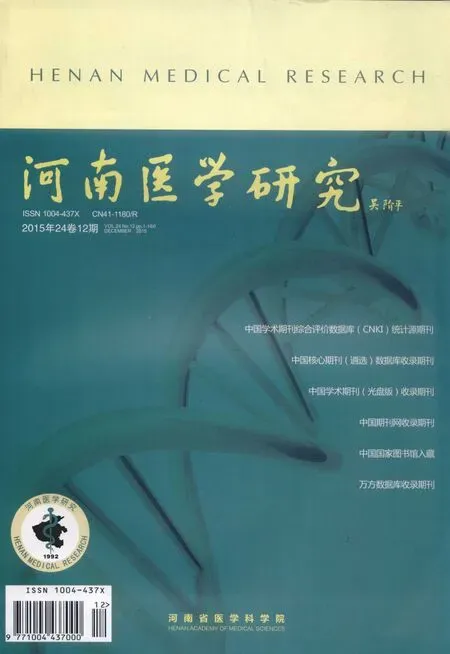干细胞衰老的调控机制
马珊珊 姚宁 王欣欣 邢衢 韩康 孟楠 关方霞,,3
(1.郑州大学生命科学学院 干细胞研究室 河南 郑州 450001;2.郑州大学第一附属医院 干细胞研究室 河南 郑州 450001;3.河南省医学科学院 河南 郑州 450003)
干细胞是一类具有自我更新和多向分化潜能的细胞群体。干细胞在特定的微环境下可分化为骨、脂肪、神经、肝脏等组织细胞,同时分泌多种生长因子和活性物质,为维持机体稳态和损伤修复发挥重要作用。曾经,人们一度认为干细胞是永生的,随着年龄的增长或体外传代次数的增加,许多干细胞,如血液、大脑、骨骼肌、皮肤、间充质干细胞的自我更新能力下降,细胞发生衰老,最终导致机体组织退化和功能障碍,产生衰老相关的疾病。随着研究的深入,干细胞衰老可能与DNA损伤、线粒体功能障碍、端粒长度、衰老相关基因表达和表观遗传调控等因素相关[1-2]。本文主要讨论这些因素对干细胞衰老的影响,总结干细胞衰老的调控机制。
1 DNA损伤与干细胞衰老
DNA是遗传信息的载体,DNA的完整性对遗传信息的维持至关重要。然而,当受到紫外线、电离辐射、化学诱变以及机体自身代谢产生的自由基(又称活性氧,reactive oxygen species,ROS)刺激时会造成DNA损伤,而DNA损伤的积累会导致机体的衰老[3]。Jeong等[4]发现复制性衰老的人骨髓间充质干细胞的内源性ROS水平明显增加。机体中超氧化物歧化酶(SOD)的活性高低反映机体清除自由基的能力,随着年龄的增加,SOD的活性逐渐降低促使细胞衰老,加速细胞死亡[5]。为了维持基因组的完整性和高度保真性,机体在长期进化过程中产生了针对损伤的DNA修复机制。KU80、ATM和WRN等蛋白参与DNA损伤修复,当DNA损伤修复出现缺陷时不能维护基因组完整性,引起干细胞功能障碍、衰老和凋亡[6-7]。Rossi等[8]发现Xpd基因(一个DNA修复系统的主要成员)突变的小鼠表现为骨质疏松、驼背、骨硬化、不孕等早衰特征;而且Xpd缺失虽然没有导致造血干细胞的损耗,但是随着年龄的增长,造血干细胞的重构和增殖能力受到严重影响。此外,年龄依赖性的DNA损伤积累可能会引起干细胞尤其是诱导多能干细胞(iPSC)的衰老,从而降低其功能性[9]。最新研究[10]发现使用干扰素可以扩大DNA损伤反应,进而激活p53通路,通过缩短端粒长度促进衰老,抑制干细胞的功能。而持续的DNA损伤可抑制DNA合成、改变人骨髓间充质干细胞的形态特征,促进衰老[11]。这些结果说明DNA损伤和损伤通路在细胞衰老和干细胞早衰过程中发挥重要作用。
2 线粒体功能障碍与干细胞衰老
线粒体是细胞中生成ATP、进行有氧呼吸的主要场所,它拥有自身DNA,在维持Ca2+体内平衡、调控细胞分化、凋亡等过程中发挥重要作用[12]。随着年龄的增长,ROS增加造成线粒体DNA突变累积,线粒体功能障碍,最终导致细胞和机体衰老[13-14]。敲除线粒体DNA聚合酶会导致小鼠发生脱毛、生殖力下降、神经系统和造血功能障碍等早衰现象[15-16]。此外,当线粒体DNA损伤到一定程度或线粒体中的特定位点基因突变会导致线粒体功能障碍,影响干细胞功能,导致衰老相关疾病的发生[17]。
FOXOs是线粒体生物合成和代谢的关键因子,FOXO的表达上调有助于改善线粒体功能,提高抗氧化能力,防止细胞衰老。FOXO3a是与人类寿命密切相关的基因[18]。FOXO3a基因缺失的小鼠ROS水平增加,抗氧化能力降低,造血干细胞和神经干细胞增殖和分化潜能下降,表现为ROS诱导的干细胞衰老和缺乏[19-21]。此外,FOXO3a低表达还增加p38MAPK磷酸化,调控下游基因的表达进而降低造血干细胞的功能和稳态,使用抗氧化剂可以显著降低缺陷鼠p38MAPK表达,从而改善造血干细胞的自我更新和分化能力[22-23]。因此,线粒体功能障碍导致ROS增加,引起干细胞衰老,加速组织衰老[24]。
3 端粒长度与干细胞衰老
端粒是位于真核细胞染色体末端的DNA-蛋白质复合体,对保持染色体的稳定性和完整性具有重要作用[25-26]。端粒酶是一种DNA聚合酶,可以使端粒延长。研究发现,第一代缺失端粒酶活性的小鼠(G1Terc-/-)表型正常,连续传代三代后(G3Terc-/-)小鼠出现明显的端粒缩短和染色体末端融合,小鼠寿命缩短,生殖能力减退,器官衰竭[26]。进一步研究发现,衰老的第三代端粒酶敲除小鼠引起造血干细胞数目减少,其造血干细胞自我更新能力和分化能力下降[27]。端粒功能障碍通过激活细胞内在的检测点和诱导干细胞微环境的改变,进而减弱干细胞的功能,促进细胞衰老[28-29]。因此,端粒是保持基因组完整性的关键因素,端粒酶的活性调控干细胞端粒长度,进而影响其细胞增殖状态[30]。
4 衰老相关基因与干细胞衰老
越来越多的结果表明细胞衰老是受基因调控的,某些基因的表达差异与细胞衰老密切相关。目前已经明确两条经典的信号通路在细胞衰老中发挥重要作用:p53-p21-pRB和p16-pRB通路。p53基因参与DNA损伤修复、自由基清除,是一种在体内衰老和体外复制损伤的共同靶点和途径。Insinga等[31]发现当造血祖细胞受到DNA损伤时,激活p53从而上调p21的表达,使造血干细胞处于衰老状态。Armesilla-Diaz等[32]发现随着年龄的增加,间充质干细胞形态发生改变,细胞周期停滞在G0期,增殖能力下降,p53表达上升,凋亡细胞数目增加;而p53缺陷小鼠干细胞增殖和分化能力明显高于野生鼠[33]。Yew等[34]发现随着干细胞体外传代次数的增加,p21蛋白表达增加,增殖和分化能力降低;干扰p21表达后,β-半乳糖苷酶活性降低,增殖能力得到改善。Hong等[35]研究表明,当阻断p53-p21信号通路时,能够显著提高干细胞的数目和分化能力。
p16Ink4a也是细胞生命周期的关键调控基因,负责细胞增殖及分裂,通过p16-cylinD/CDK-RB途径调控细胞周期,影响干细胞增殖和分化功能[36]。Molofsk等[37]发现随着年龄增加,神经干细胞的数量和自我更新降低,p16INK4a的表达增加。相反,p16INK4a基因敲除的小鼠造血干细胞比同窝野生型的小鼠增殖能力强,显著增强老年小鼠的神经干细胞的神经再生能力,延缓大脑的衰老过程[36]。所以,p16INK4a的表达促进造血干细胞、神经干细胞和胰腺等干细胞的衰老,进而抑制干细胞的增殖和活性[38]。
5 表观遗传调控与干细胞衰老
表观遗传调控也是影响干细胞衰老的关键因素之一。表观遗传修饰主要包括DNA甲基化、组蛋白修饰、RNA干扰、染色质重塑等。DNA甲基化是通过在基因组CpG岛的胞嘧啶被选择性地添加甲基从而增加DNA稳定性和调控基因表达,发挥维持干细胞正常功能的作用[1]。Dnmt3a和Dnmt3b是DNA甲基化的重要基因。Dnmt3a和Dnmt3b基因缺失小鼠的造血干细胞造血功能丧失,抑制了造血干细胞的分化能力[39]。组蛋白甲基化是另一种甲基化形式。PcG蛋白是一种组蛋白甲基转移酶复合体,甲基转移酶Ezh1和Ezh2是PRC2复合体中的催化组分,Ezh1和Ezh2基因缺失小鼠对p16INK4a的表观抑制作用减弱,从而诱发造血干细胞衰老[40-41]。
组蛋白修饰主要是针对核心组蛋白进行翻译后共价修饰,主要是组蛋白H3和H4N端赖氨酸位点乙酰化修饰Sirtuins家族是组蛋白去乙酰化酶的第3个家族,在调控细胞周期、有丝分裂、染色质重塑等过程中发挥作用[28]。目前研究较多的是具有年龄成负相关的Sirt1和Sirt2蛋白[42-43]。Gurd等[44]发现Sirt1可以使MSCs抵抗不良环境因素对细胞造成的损伤,从而延长MSCs的寿命。Rathbone等[45-46]研究表明Sirt1在肌肉干细胞中也可以促进细胞增殖延缓干细胞衰老,抑制Sirt1可促使p53激活下游靶基因转录活性,导致细胞衰老。此外,Sirt1蛋白结合叉头蛋白类转录因子FOXO并将其去乙酰化,减弱FOXO3所诱导的凋亡,从而促进细胞在应激条件下的细胞存活,延长细胞寿命[19]。
6 结语
细胞衰老是机体衰老的基础,干细胞衰老可以诱导机体衰老的发生发展。研究显示DNA损伤、线粒体功能障碍、端粒长度、衰老相关基因以及表观遗传学调控等均影响干细胞的衰老。这些事件并不是独立存在的,而是彼此之间相互联系。例如氧化应激导致DNA损伤和端粒缩短,而端粒长度缩短也将引起DNA损伤。我们从这些方面阐述了干细胞衰老的调控机制,但对于诱导衰老的影响因素以及衰老的发生、发展机制仍需深入研究,如果能揭示干细胞衰老的分子机制,将为进一步寻求延缓干衰老的方法或药物提供依据,对机体衰老及相关疾病的治疗具有重大的生物学意义和临床应用前景。
[1]Beerman I,Rossi D J.Epigenetic regulation of hematopoietic stem cell aging[J].Exp Cell Res,2014,329(2):192-199.
[2]Nurkovic JS,Volarevic V,Lako M,et al.Aging of stem and progenitor cells:mechanisms,Impact on the Therapeutic Potential and Rejuvenation[J].Rejuv Res,2015:26055182.
[3]Alves H,Munoz-Najar U,de Wit J,et al.A link between the accumulation of DNA damage and loss of multi-potency of human mesenchymal stromal cells[J].J Cell Mol Med,2010,14(12):2729-2738.
[4]Jeong SG,Cho G W.Endogenous ROSlevels are increased in replicative senescence in human bone marrow mesenchymal stromal cells[J].Biochem BiophysRes Commun,2015,460(4):971-976.
[5]Blanpain C,Mohrin M,Sotiropoulou P A,et al.DNA-Damage Response in Tissue-Specific and Cancer Stem Cells[J].Cell stem cell,2011,8(1):16-29.
[6]Hasty P,Campisi J,Hoeijmakers J,et al.Aging and genome maintenance:Lessons from the mouse[J].Science,2003,299(5611):1355-1359.
[7]Nijnik A,Woodbine L,Marchetti C,et al.DNA repair is limiting for haematopoietic stem cells during ageing[J].Nature,2007,447(7145):686-690.
[8]Rossi D J,Bryder D,Seita J,et al.Deficiencies in DNA damage repair limit the function of haematopoietic stem cells with age[J].Nature,2007,447(7145):725-729.
[9]Feng Q,Lu SJ,Klimanskaya I,et al.Hemangioblastic derivatives from human induced pluripotent stem cells exhibit limited expansion and early senescence[J].Stem Cells,2010,28(4):704-712.
[10]Yu Q,Katlinskaya Y V,Carbone CJ,et al.DNA-damage-induced type I interferon promotes senescence and inhibits stem cell function[J].Cell reports,2015,11(5):785-797.
[11]Minieri V,Saviozzi S,Gambarotta G,et al.Persistent DNA damageinduced premature senescence alters the functional features of human bone marrow mesenchymal stem cells[J].J Cell Mol Med,2015,19(4):734-743.
[12]Chen C T,Hsu SH,Wei Y H.Upregulation of mitochondrial function and antioxidant defense in the differentiation of stem cells[J].Bba-Gen Subjects,2010,1800(3):257-263.
[13]Kujoth G C,Hiona A,Pugh T D,et al.Mitochondrial DNA mutations,oxidative stress,and apoptosis in mammalian aging[J].Science,2005,309(5733):481-484.
[14]Wallace D C.A mitochondrial paradigm of metabolic and degenerative diseases,aging,and cancer:A dawn for evolutionary medicine[J].Annu Rev Genet,2005,39:359-407.
[15]Ahlqvist K J,Hamalainen R H,Yatsuga S,et al.Somatic progenitor cell vulnerability to mitochondrial DNA mutagenesis underlies progeroid phenotypes in Polg mutator mice[J].Cell Metab,2012,15(1):100-109.
[16]Ahlqvist K J,Suomalainen A,Hamalainen R H.Stem cells,mitochondria and aging[J].Biochim Biophys Acta,2015,1847(11):1380-1386.
[17]Edgar D,Shabalina I,Camara Y,et al.Random point mutations with major effects on protein-coding genes are the driving force behind premature aging in mtDNA mutator mice[J].Cell Metab,2009,10(2):131-138.
[18]Flachsbart F,Caliebeb A,Kleindorp R,et al.Association of FOXO3A variation with human longevity confirmed in German centenarians[J].Proc Natl Acad Sci U SA,2009,106(8):2700-2705.
[19]Paik J H,Ding Z H,Narurkar R,et al.FoxOs cooperatively regulate diverse pathways governing neural stem cell homeostasis[J].Cell stem cell,2009,5(5):540-553.
[20]Renault V M,Rafalski V A,Morgan A A,et al.FoxO3 regulates neural stem cell homeostasis[J].Cell stem cell,2009,5(5):527-539.
[21]Tothova Z,Kollipara R,Huntly B J,et al.FoxOs are critical mediators of hematopoietic stem cell resistance to physiologic oxidative stress[J].Cell,2007,128(2):325-339.
[22]Li X,Zhang T,Wilson A,et al.Transcriptional profiling of Foxo3a and Fancd2 regulated genes in mouse hematopoietic stem cells[J].Genomics data,2015,4:148-149.
[23]Miyamoto K,Araki K Y,Naka K,et al.Foxo3a is essential for maintenance of the hematopoietic stem cell pool[J].Cell stem cell,2007,1(1):101-112.
[24]Borodkina A,Shatrova A,Abushik P,et al.Interaction between ROS dependent DNA damage,mitochondria and p38 MAPK underlies senescence of human adult stem cells[J].Aging-Us,2014,6(6):481-495.
[25]Flores I,Canela A,Vera E,et al.The longest telomeres:a general signature of adult stem cell compartments[J].Gene Dev,2008,22(5):654-667.
[26]Ju Z Y,Jiang H,Jaworski M,et al.Telomere dysfunction induces environmental alterations limiting hematopoietic stem cell function and engraftment[J].Nat Med,2007,13(6):742-747.
[27]Sahin E,DePinho R A.Linking functional decline of telomeres,mitochondria and stem cells during ageing[J].Nature,2010,464(7288):520-528.
[28]Signer R A,Morrison S J.Mechanisms that regulate stem cell aging and life span[J].Cell stem cell,2013,12(2):152-165.
[29]Tumpel S,Rudolph K L.The role of telomere shortening in somatic stem cells and tissue aging:lessons from telomerase model systems[J].Ann Ny Acad Sci,2012,1266(1):28-39.
[30]Meena J K,Cerutti A,Beichler C,et al.Telomerase abrogates aneuploidy-induced telomere replication stress,senescence and cell depletion[J].Embo J,2015,34(10):1371-1384.
[31]Insinga A,Cicalese A,Faretta M,et al.DNA damage in stem cells activates p21,inhibits p53,and induces symmetric self-renewing divisions[J].Proc Natl Acad Sci U SA,2013,110(10):3931-3936.
[32]Armesilla-Diaz A,Elvira G,Silva A.p53 regulates the proliferation,differentiation and spontaneous transformation of mesenchymal stem cells[J].Exp Cell Res,2009,315(20):3598-3610.
[33]Dumble M,Moore L,Chambers S M,et al.The impact of altered p53 dosage on hematopoietic stem cell dynamics during aging[J].Blood,2007,109(4):1736-1742.
[34]Yew T L,Chiu F Y,Tsai C C,et al.Knockdown of p21(Cip1/Waf1)enhances proliferation,the expression of stemness markers,and osteogenic potential in human mesenchymal stem cells[J].Aging cell,2011,10(2):349-361.
[35]Hong H,Takahashi K,Ichisaka T,et al.Suppression of induced pluripotent stem cell generation by the p53-p21 pathway[J].Nature,2009,460(7259):1132-1135.
[36]Janzen V,Forkert R,Fleming H E,et al.Stem-cell ageing modified by the cyclin-dependent kinase inhibitor p16INK4a[J].Nature,2006,443(7110):421-426.
[37]Molofsky A V,Slutsky S G,Joseph N M,et al.Increasing p16INK4a expression decreases forebrain progenitors and neurogenesis during ageing[J].Nature,2006,443(7110):448-452.
[38]Krishnamurthy J,Ramsey M R,Ligon K L,et al.p16INK4a induces an age-dependent decline in islet regenerative potential[J].Nature,2006,443(7110):453-457.
[39]Challen G A,Sun D Q,Jeong M,et al.Dnmt3a is essential for hematopoietic stem cell differentiation[J].Nat Genet,2012,44(1):23-31.
[40]Bracken A P,Kleine-Kohlbrecher D,Dietrich N,et al.The Polycomb group proteins bind throughout the INK4A-ARF locus and are disassociated in senescent cells[J].Genes Dev,2007,21(5):525-530.
[41]Radulovic V,de Haan G,Klauke K.Polycomb-group proteins in hematopoietic stem cell regulation and hematopoietic neoplasms[J].Leukemia,2013,27(3):523-533.
[42]Bosch-Presegue L,Vaquero A.The dual role of sirtuins in cancer[J].Genes&cancer,2011,2(6):648-662.
[43]Yuan H F,Zhai C,Yan X L,et al.SIRT1 is required for long-term growth of human mesenchymal stem cells[J].J Mol Med,2012,90(4):389-400.
[44]Gurd B J,Perry C G,Heigenhauser G J,et al.High-intensity interval training increases SIRT1 activity in human skeletal muscle[J].Appl Physiol Nutr Me,2010,35(3):350-357.
[45]Chen H Q,Liu X B,Chen H,et al.Role of SIRT1 and AMPK in mesenchymal stem cells differentiation[J].Ageing Res Rev,2014,13:55-64.
[46]Rathbone CR,Booth F W,Lees SJ.Sirt1 increases skeletal muscle precursor cell proliferation[J].Eur JCell Biol,2009,88(1):35-44.

